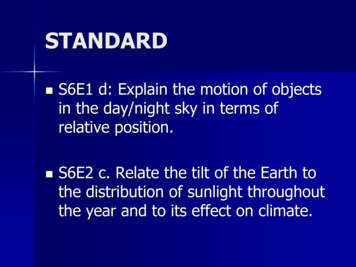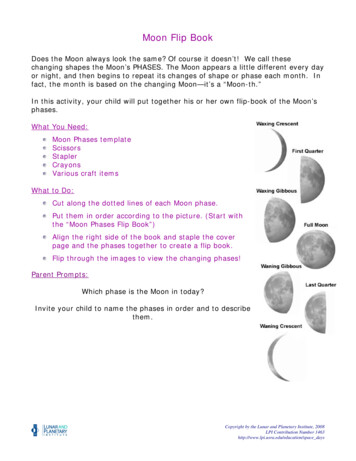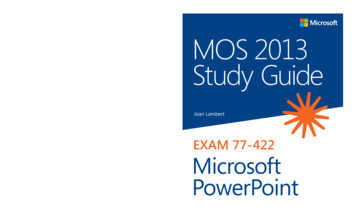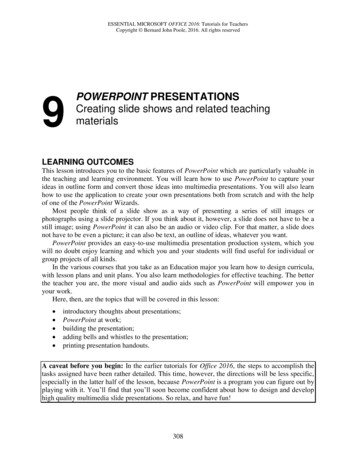
Transcription
STANDARD S6E1 d: Explain the motion of objectsin the day/night sky in terms ofrelative position.S6E2 c. Relate the tilt of the Earth tothe distribution of sunlight throughoutthe year and to its effect on climate.
ESSENTIAL QUESTION How can I describe phases of themoon?
OPENING United Streaming Video over phases ofthe moon: Phases & Rotations of themoon
Work Period Power-point over moon phasesMoon phase activity sheetComplete lab 74 “As Earth Rotates”with analysis questions
CLOSING Submit work
HOMEWORK Note-taking handout over moonphases due Friday Bring Oreos for lab activity Study notes & vocabulary
Phases of the MoonCreated by Mrs. Bodine-Donahue
The lunar month is the 28 days ittakes to go from one new moon to thenext. During the lunar month, theMoon goes through all its phases.
We only seethe Moonbecausesunlightreflects backto us fromits surface.
During the course of a month, the Mooncircles once around the Earth. If we couldmagically look down on our solar system,we would see that the half of the Moonfacing the Sun is always lit. But the lit sidedoes not always face the Earth!
As the Mooncircles the Earth,the amount of thelit side we seechanges. Thesechanges are knownas the phases ofthe Moon and itrepeats in acertain way overand over.
Moon Phase Descriptions.Although this cycle is a continuousprocess, there are eight distinctstages, called phases. These phases ofthe Moon, in the sequence of theiroccurrence (starting from New Moon),are shown below.
New Moon - The Moon's dark side is facing theEarth. The Moon is not visible. The lighted sideof the Moon faces away from the Earth. Thismeans that the Sun, Earth, and Moon are almostin a straight line, with the Moon in between theSun and the Earth. The Moon that we see looksvery dark.
Waxing Crescent Moon - As the Moon movesaround the Earth, we get to see more and more ofthe illuminated half, and we say the Moon iswaxing. At first we get a sliver of it, which growsas days go by. This phase is called the crescentmoon.
Quarter Moon - A week after the new moon,when the Moon has completed about a quarterof its turn around the Earth, we can see halfof the illuminated part; that is, a quarter ofthe Moon. This is the first quarter phase.
Waxing Gibbous - The Moon appears to be morethan one-half but not fully illuminated by directsunlight. The fraction of the Moon's disk that isilluminated is increasing. This Moon can be seenafter the First Quarter Moon, but before the FullMoon. The amount of the Moon that we can seewill grow larger and larger every day. ("Waxing"means increasing, or growing larger.)
Full Moon - The Moon's illuminated side is facingthe Earth. The Moon appears to be completelyilluminated by direct sunlight. The lighted side ofthe Moon faces the Earth. This means that theEarth, Sun, and Moon are nearly in a straight line,with the Earth in the middle. The Moon that wesee is very bright from the sunlight reflecting offit.
Waning Gibbous Moon - From now on, until itbecomes new again, the illuminated part of theMoon that we can see decreases, and we say it'swaning. The first week after full, it is calledwaning gibbous. The amount of the Moon that wecan see will grow smaller and smaller every day.("Waning" means decreasing, or growing smaller.)
Last Quarter - One-half of the Moon appears to beilluminated by direct sunlight. The fraction of the Moon's diskthat is illuminated is decreasing. Sometimes called ThirdQuarter. The left half of the Moon appears lighted, and theright side of the Moon appears dark. During the timebetween the Full Moon and the Last Quarter Moon, the partof the Moon that appears lighted gets smaller and smallerevery day. It will continue to shrink until the New Moon.
Waning Crescent - The Moon appears to be partlybut less than one-half illuminated by directsunlight. The fraction of the Moon's disk that isilluminated is decreasing. This Moon can be seenafter the Last Quarter Moon and before the NewMoon. The crescent will grow smaller and smallerevery day, until the Moon looks like the New Moon.
A while after four weeks the illuminated half ofthe Moon again faces away from us, and we comeback to the beginning of the cycle: a new moon.
Moon Phase Misconception."The most common incorrect reason given for the cause of theMoon's phases is that we are seeing the shadow of the Earthon the Moon! But this cannot be correct: when the Moon passesthrough the shadow of the Earth, we get a lunar eclipse.Anyone who has seen a lunar eclipse, though, might rememberthat the Moon actually passes through the Earth's shadow onlyrarely, so that can't be why the Moon has phases. The realreason for the Moon's phases depends on two things: the Moonis round, and the angle it makes with the Earth and Sunchanges over its orbit."- As Quoted From Bad Astronomy
New Moon - The Moon's dark side is facing the Earth. The Moon is not visible. The lighted side of the Moon faces away from the Earth. This means that the Sun, Earth, and Moon are almost in a straight line, with the Moon in between the Sun and the Earth. The Moon that we see looks very dark.











